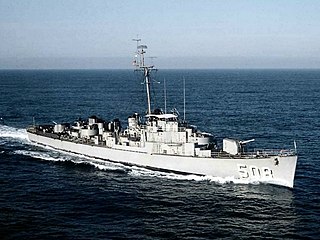
USS Abercrombie (DE-343) was a John C. Butler-class destroyer escort in the service of the United States Navy from 1944 to 1946. She was finally sunk as a target in 1968.

USS John D. Henley (DD-553), a Fletcher-class destroyer, was a ship of the United States Navy named for Captain John D. Henley (1781–1835).

USS Currier (DE-700) was a Buckley-class destroyer escort in service with the United States Navy from 1944 to 1960. She was sunk as a target in 1967.

USS Marshall (DD-676) was a Fletcher-class destroyer of the United States Navy.

USS Robert F. Keller (DE-419) was a John C. Butler-class destroyer escort in service with the United States Navy from 1943 to 1965. She was scrapped in 1974.

USS Highlands (APA-119) was a Haskell-class attack transport built and used by the US Navy in World War II. She was a Victory ship design, VC2-S-AP5. She was named after Highlands County, Florida, United States.

USS Thaddeus Parker (DE-369) was a John C. Butler-class destroyer escort in service with the United States Navy from 1944 to 1946 and from 1951 to 1967. She was scrapped in 1968.
USS Motive (AM-102) was an Auk-class minesweeper built for the United States Navy during World War II. She earned three battle stars for World War II service. She was decommissioned in 1946 and placed in reserve where she remained until struck from the Naval Vessel Register in December 1966. She was sunk as a target in April 1968.
USS Oracle (AM-103) was an Auk-class minesweeper built for the United States Navy during World War II. She was commissioned in May 1943 and decommissioned in May 1946. She was placed in reserve and remained there until struck from the Naval Vessel Register in December 1966. She was sunk as a target in 1967.
USS Specter (AM-306) was an Admirable-class minesweeper built for the United States Navy during World War II. She was originally ordered, laid down, and launched as USS Spector (AM-306), but was renamed the correctly spelled Specter in March 1944. She was awarded four battle stars for service in the Pacific during World War II. She was decommissioned in 1946 and placed in reserve. While she remained in reserve, Specter was reclassified as MSF-306 in February 1955 but never reactivated. In April 1973, she was sold to the Mexican Navy and renamed ARM DM-04. In 1994 she was renamed ARM General Manuel E. Rincón (C52). She was stricken in July 2001, but her ultimate fate is not reported in secondary sources.

USS Dionne (DE-261) was an Evarts-class destroyer escort of the United States Navy during World War II. She was sent off into the Pacific Ocean to protect convoys and other ships from Japanese submarines and fighter aircraft. She performed escort and antisubmarine operations in dangerous battle areas and returned home with six battle stars, a high number for a ship of her type.

USS Snyder (DE-745) was a Cannon-class destroyer escort built for the United States Navy during World War II. She served in the Pacific Ocean and provided escort service against submarine and air attack for Navy vessels and convoys.
USS Hilarity (AM-241) was an Admirable-class minesweeper built for the United States Navy during World War II. She was awarded two battle stars for service in the Pacific during World War II. She was decommissioned in 1946 and placed in the Atlantic Reserve Fleet. While she remained in reserve, Hilarity was reclassified as MSF-241 in February 1955 but never reactivated. In October 1962, she was sold to the Mexican Navy and renamed ARM DM-02. She was stricken in 1986 and scrapped in August 1988.

USS George E. Davis (DE-357) was a John C. Butler-class destroyer escort acquired by the U.S. Navy during World War II. The primary purpose of the destroyer escort was to escort and protect ships in convoy, in addition to other tasks as assigned, such as patrol or radar picket.

USS John L. Williamson (DE-370) was a John C. Butler-class destroyer escort acquired by the U.S. Navy during World War II. The primary purpose of the destroyer escort was to escort and protect ships in convoy, in addition to other tasks as assigned, such as patrol or radar picket.

USS Straus (DE-408) was a John C. Butler-class destroyer escort in service with the United States Navy from 1944 to 1947. She was finally sunk as a target in 1973.

USS McCoy Reynolds (DE-440) was a John C. Butler-class destroyer escort acquired by the U.S. Navy during World War II. The primary purpose of the destroyer escort was to escort and protect ships in convoy, in addition to other tasks as assigned, such as patrol or radar picket. Post-war, after operating in the Pacific Ocean battle areas, her crew members returned home with four battle stars to their credit for World War II and one for the Korean War.

USS Gilligan (DE-508) was a John C. Butler-class destroyer escort acquired by the U.S. Navy during World War II. The primary purpose of the destroyer escort was to escort and protect ships in convoy, in addition to other tasks as assigned, such as patrol or radar picket. After the war, she returned home with one battle star to her credit.

USS Silverstein (DE-534) was a John C. Butler-class destroyer escort in service with the United States Navy from 1944 to 1947 and from 1951 to 1958. She was sold for scrapping in 1973.

USS Fieberling (DE-640) was a Buckley-class destroyer escort in service with the United States Navy from 1944 to 1948. She sold for scrap in 1972.
















